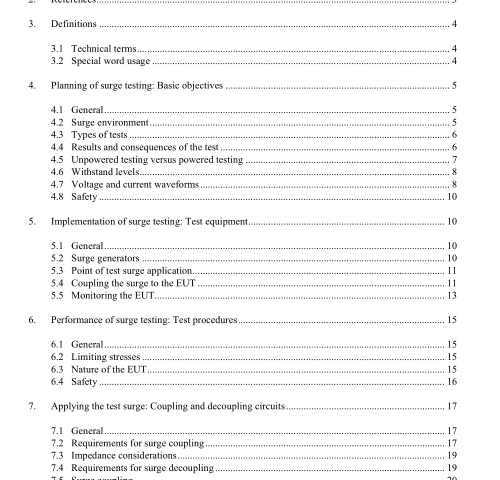IEEE C62.35-2010 pdf download.IEEE Recommended Practice on Surge Testing for Equipment Connected to Low-Voltage (1000 V and Less) AC Power Circuits
3. Definitions
3.1 Technical terms
The definitions of the terms used in this recommended practice are those found in The Authoritative Dictionary of IEEE Standards Terms, Seventh Edition [B11] 8 , or in IEC 61643-1 [B10]. No new definitions have been generated in developing this document. However, as a reference for the reader and for tutorial purposes, some already existing definitions and related comments may be found in the Glossary provided as Annex C of IEEE Std C62.41.1-2002.
3.2 Special word usage
The words listed below are used in this recommended practice in accordance with the IEEE Standards Style Manual, the IEC/ISO Directives, or specific limitation of a term in general use; they convey the following meanings: 3.2.1 will: Conveys the certain occurrence of an event.
3.2.2 can, cannot: Conveys (im)possibility or (in)capability, whether material, physical, or causal.
3.2.3 may, may not: Conveys that a course of action by the equipment user or test operator is permissible (not permissible) within the limits of the present recommended practice, or that it is (im)possible to exercise a choice at the discretion of the sponsor. See: might.
3.2.4 might: Conveys the possible occurrence of a situation or phenomenon, without intervention from the user or test operator, with actual occurrence uncertain. See: may.
3.2.5 must: Conveys the necessity of a course of action by the test operator in order to obtain reliable results or observe appropriate safety precautions.
3.2.6 reader: The person using this document for any purpose.
3.2.7 shall: Conveys requirements to be strictly followed to conform to a specification or stipulation, from which no deviation is permitted.
3.2.8 should, should not: Conveys a preference among several possibilities, but not necessarily a requirement. In the negative form, conveys deprecation, but not prohibition, of a course of action.
3.2.9 sponsor: The entity for which the tests are being performed in accordance with the present recommended practice.
3.2.10 user: The occupant, owner, or operator of the power system or premises where the equipment under test (EUT) is intended to be installed.
4. Planning of surge testing: Basic objectives
4.1 General
This clause outlines the basic objectives to be considered for planning surge testing, as shown in Figure 1. Detailed discussions of these considerations are provided in Annex B. Although the scope of this recommended practice addresses only the power port of equipment, the intended application and multiple ports of the equipment under test (EUT) should also be considered. Six ports (see Figure 2), through which electromagnetic disturbances can be coupled into equipment, can be identified as follows:
— Enclosure port (radiated disturbance only)
— AC power port
— DC power port
— Process measurement and control port
— Signal port
— Earth port
Radiated coupling of disturbances through the envelope is clearly outside the scope of the present recommended practice and is addressed in other documents related to electromagnetic compatibility. The scope of this recommended practice specifically excludes signal and data lines and, by implication, the dc power port. However, the sixth port, referred to as earth port (earth being the term used by the IEC, and ground, the term used in the USA), should be recognized. (See discussion of grounding practices in B.5 and B.23.) The issue is that equipment connected to different systems can be exposed to different reference voltages through their separate connection to those different systems. (In many systems, the reference point is a grounded conductor that, during a surge event, experiences changes of potential.) Subclause 4.4 of IEEE Std C62.41.1-2002 provides a detailed description of this issue. Thus, while planning surge testing for the ac interface of the equipment, a complete evaluation of the equipment performance under surge conditions requires recognition of the occurrence of surges on all ports.IEEE C62.35 pdf download.IEEE C62.35-2010 pdf download
IEEE C62.35-2010 pdf download

Leave a Reply